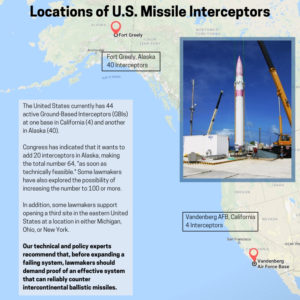National missile defense: defense theology with unproven technology.
Since programs were first launched in the 1950s to build systems capable of intercepting incoming nuclear or conventional weapons, the United States has spent more than $400 billion on various missile defense programs. Despite decades of research, development and testing, there remains no reliably effective anti-missile system to counter intercontinental ballistic missiles (ICBMs). Systems to counter shorter-range missiles, such as the Patriot and THAAD missile defense programs, have been more successful in tests, but their utility is limited to smaller, regional coverage areas. In fact, the system designated to intercept ICBMs, known as the Ground-based Midcourse Defense (GMD) program, has been unsuccessful in eight of its 19 tests. This failing test record is exacerbated by the highly scripted conditions of the tests themselves.
Here’s how it’s supposed to work: interceptors attempt to destroy an incoming ICBM traveling roughly 15,000 miles per hour, or about 20 times faster than the speed of sound, by flying into its path and releasing a kill vehicle to physically collide with the warhead. When the Missile Defense Agency (MDA) tests GMD, it assumes prime weather and lighting conditions — and, being a test, it knows the timing and other information that no enemy would provide. Nonetheless, the testing record is no better than a flip of the coin.
GMD is also exceptionally expensive. The Government Accountability Office (GAO) assesses that the total cost of the program will be approximately $53 billion — and that cost estimate will almost certainly increase. But despite the hefty price tag and poor test record, some lawmakers want to expand GMD without first proving that the system is effective.
Finally, even a working missile defense system would still be risky, because it reduces focus on resolving disputes diplomatically while adversaries can still simply build more missiles to defeat missile defense systems — for far cheaper than the defense systems themselves. According to former Assistant Secretary of Defense and U.S. chief weapons evaluator Philip Coyle, “All missile defense systems can be overwhelmed. All missile defense systems have limitations and those limitations can be exploited by the offense. By definition, it is only if the attack is limited that the defense can have a hope of not being overwhelmed.” An offense-defense arms race is a dangerous, destabilizing cycle, and the offense always has the advantage.
Five things to know about GMD
Have 90 seconds? Learn what you need to know.
Star Wars: The Phantom Interceptor
The problem with GMD: “If you miss by an inch, you miss by a mile.”
In this clip from our May 31, 2017, Nukes of Hazard podcast, former Assistant Secretary of Defense and U.S. chief weapons evaluator Philip Coyle, a Center board member, explains why it’s not necessarily a success when the MDA’s interceptors fully destroy a target when testing — and why coming close is of no value.
FAQ: “Isn’t having something better than nothing?”
At a total cost of nearly $70 billion (a figure likely to increase), the Ground-based Midcourse Defense (GMD) program has a failing test record. In a real-world scenario, the system cannot be relied upon to protect the United States from even an extremely limited attack. In this case — a nuclear attack against the homeland — deploying a failing system to attempt to thwart the attack makes little, if any, difference to not having any system at all.
Lawmakers have an obligation to undertake a rigorous cost-benefit analysis of complex military programs. Unfortunately, such an analysis has not been thoroughly conducted related to GMD. Every dollar spent expanding GMD, without first proving that the system works, is a dollar not spent on other, effective security and diplomatic programs that have been proven to enhance U.S. national security. Read more FAQs
Recent Analysis on Missile Defense
- How Iran breached Israel’s air defence by overwhelming it with missiles October 2, 2024
- How Iran may have breached the world’s best air defences October 2, 2024
- Comparative Summary: Fiscal Year 2025 National Defense Authorization Act September 12, 2024
- Trump has long promised a ‘beautiful’ wall. Now he’s pledging ‘the greatest dome ever.’ January 23, 2024
- The Right and Wrong Lessons to Learn from Missile Defense in Ukraine October 19, 2023
- Why Israel’s Iron Dome couldn’t stop every rocket strike from Hamas October 11, 2023
- Summary: Comparison of Fiscal Year 2024 National Defense Authorization Act (H.R. 2670/S. 2226) as passed by the U.S. House of Representatives and U.S. Senate August 29, 2023
- Summary: Fiscal Year 2024 National Defense Authorization Act (S. 2226) as passed by the Senate Committee on Armed Services July 18, 2023
- Fiscal Year 2024 Defense Budget Request Briefing Book April 4, 2023
- Iran’s Foreign Minister admits to sending drones to Russia, admission comes after repeated denials November 6, 2022

